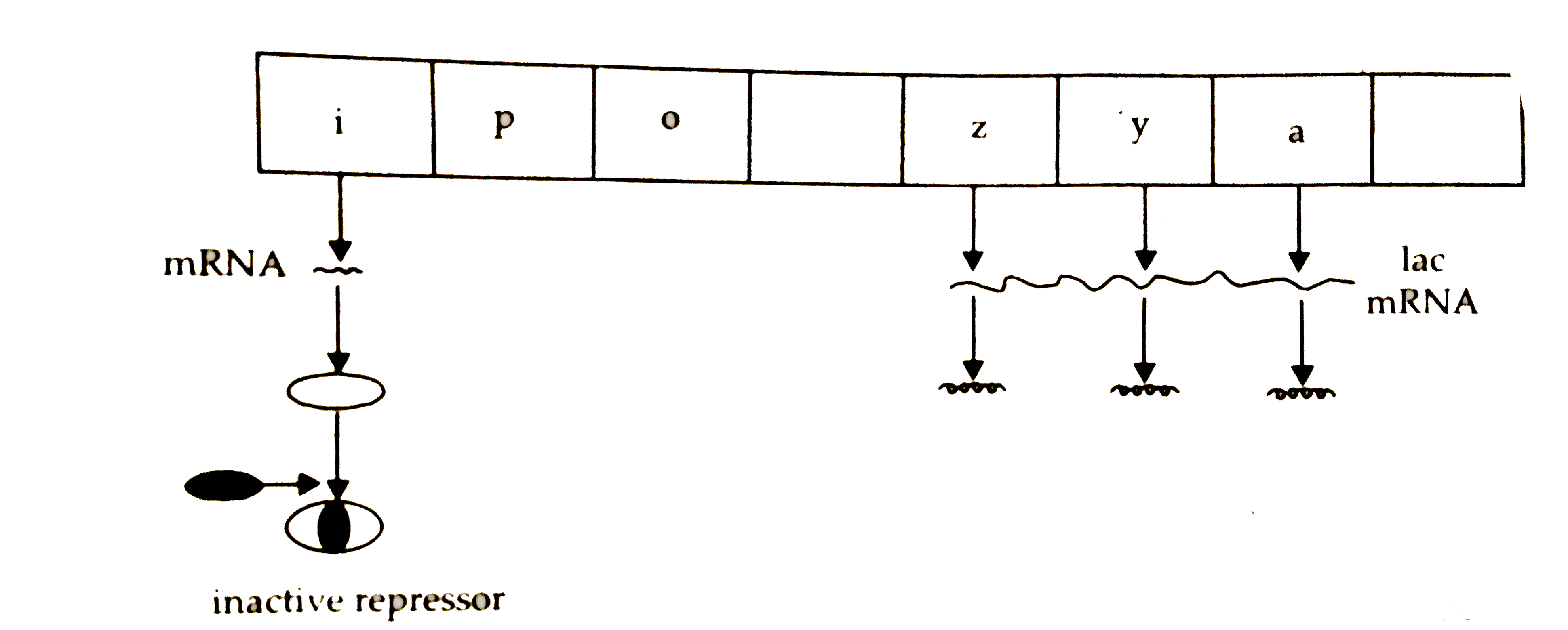
(a) Name the molecule 'X' synthesised by 'I' gene. How does this molecule get inactivated ?
(b) Which one of the structural genes code for β-galactosidase ?
(c) When will the transcription of this gene stop?
(a) Molecule 'X' synthesised by ' i' gene is repressor of the Lac operon. The repressor is inactivated by interaction with the inducer (i.e., lactose).
(b) The gene 'Z' codes for beta-galactosidase.
(c) Transcription of this gene stops as soon as the inducer is usedup i.e., in absence of inducer. Once whole of lactose is consumed and there is no inducer present to bind to the repressor, the repressor becomes active and switches off the operon.
Topper's Solved these Questions
- MOLECULAR BASIS OF INHERITANCE BOOK - PRADEEPCHAPTER - MOLECULAR BASIS OF INHERITANCE EXERCISE - ADDITIONAL QUESTIONS (LONG ANSWER QUESTIONS)
48 Videos
- MOLECULAR BASIS OF INHERITANCE BOOK - PRADEEPCHAPTER - MOLECULAR BASIS OF INHERITANCE EXERCISE - ANALYTICAL (QUESTIONS WITH ANSWERS)
20 Videos
- MOLECULAR BASIS OF INHERITANCE BOOK - PRADEEPCHAPTER - MOLECULAR BASIS OF INHERITANCE EXERCISE - ADDITIONAL QUESTIONS (VERY SHORT ANSWER QUESTIONS)
56 Videos
- MICROBES IN HUMAN WELFAREBOOK - PRADEEPCHAPTER - MICROBES IN HUMAN WELFAREEXERCISE - PRACTICE QUESTIONS (ASSERTION-REASON TYPE QUESTIONS )
12 Videos
- ORGANISMS AND POPULATIONORGANISMS AND POPULATIONSBOOK - PRADEEPCHAPTER - ORGANISMS AND POPULATIONORGANISMS AND POPULATIONSEXERCISE - Additional Questions (Very Short Answer Questions)
1 Videos
Similar Questions
Study the figure given below and answer the questions:

(i) How does the repressor molecule get inactivated?
(ii) When does the transcription of lac mRNA stop?
(iii) Name the enzyme transcribed by the gene Z'.
View SolutionStudy the figure given below and answer the questions .
How does the repressor molecule get inactivated?
When does the transcription of lac mRNA stop?
Name the enzyme transcribed by the gene 'z'.

View Solution
Knowledge Check
The structural gene that codes for transacetylase enzyme which can transfer acetyl group to β-galactoside is
Alac zBlac aCi-geneDlac yWhich of following statement is true for lac operon in E-coli
(a) lac operon consists of one regulatory gene and five structural gene.
(b) The i gene codes for inducer
(c) The z-gene codes for β -galacosidase
(d) A very low level of expression of lac operon has to be present in cell all the timeAa, b, c, dBa, c, dCc, dDb, dGo through the following statements
(i) 2'-OH group present at every nucleotide in RNA makes RNA labile and easily degradable.
(ii) The transcription and translation can be coupled in bacteria
(iii) the promoter is located towards the 5'-end while terminator is located towards the 3'end of the template strand.
(iv). In lac operon, the z gene codes for betagalactosidase, y gene codes for permease while i gene codes for the inducer.
Which of these are correct statement:A(ii),(iiii) & (iv)B(i) & (ii)C(i),(ii) & (iii)DAll are correct
Name the genes that constitute an operon. How does lac operon get switched on in the presence of lactose?
View SolutionStudy the figure given below and answer the questions :
(a) What does the figure express ?
(b) When does the transcription of lac mRNA stop ?
( c) Name the enzyme transcribed by the gene 'Z'.

View SolutionAnswer the following on the basis of lac operon-a. Name the 3 structural genes. b. Name the inducer. c Name the gene which codes for enzyme B-galactocydase. d Name the gene which codes for repressor protein e.What is the role of gene "Y"
View SolutionHow does the gene 'I' control ABO blood grous in humans? Write the effect the gene has on the structure of red blood cells.
View SolutionDo you think that the alternate splicing of exons may enable a structural gene to code for several isoproteins from one and the same gene? If yes, how? If not, why so ?
View Solution
